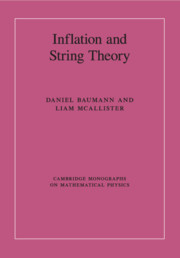Book contents
- Frontmatter
- Dedication
- Contents
- Preface
- Notation and conventions
- 1 Inflation: theory and observations
- 2 Inflation in effective field theory
- 3 Elements of string theory
- 4 What is string inflation?
- 5 Examples of string inflation
- 6 Conclusions and outlook
- Appendix A Mathematical preliminaries
- Appendix B The effective theory of inflation
- Appendix C Primordial perturbations from inflation
- References
- Index
Preface
Published online by Cambridge University Press: 05 May 2015
- Frontmatter
- Dedication
- Contents
- Preface
- Notation and conventions
- 1 Inflation: theory and observations
- 2 Inflation in effective field theory
- 3 Elements of string theory
- 4 What is string inflation?
- 5 Examples of string inflation
- 6 Conclusions and outlook
- Appendix A Mathematical preliminaries
- Appendix B The effective theory of inflation
- Appendix C Primordial perturbations from inflation
- References
- Index
Summary
The past two decades of advances in observational cosmology have brought about a revolution in our understanding of the universe. Observations of type Ia supernovae [1, 2], measurements of temperature fluctuations in the cosmic microwave background (CMB) – particularly by the Wilkinson Microwave Anisotropy Probe (WMAP) [3–7] and the Planck satellite [8–10] – and maps of the distribution of large-scale structure (LSS) [11] have established a standard model of cosmology, the ΛCDM model. This is a universe filled with 68% dark energy, 27% dark matter, and only 5% ordinary atoms [8]. There is now decisive evidence that large-scale structures were formed via gravitational instability of primordial density fluctuations, and that these initial perturbations originated from quantum fluctuations [12–17], stretched to cosmic scales during a period of inflationary expansion [18–20]. However, the microphysical origin of inflation remains a mystery, and it will require a synergy of theory and observations to unlock it.
In the standard cosmology without inflation, causal signals travel a finite distance between the time of the initial singularity and the time of formation of the first neutral atoms. However, the CMB anisotropies display vivid correlations on scales larger than this distance. This causality puzzle is known as the horizon problem. The horizon problem is resolved if the early universe went through an
extended period of inflationary expansion, i.e. expansion at a nearly constant rate, with
|Ḣ| ≪ H2,
where H ≡ ȧ/a is the Hubble parameter associated with a Friedmann–Robertson–Walker spacetime,
ds2 = −dt2 + a2(t)dx2.
Because space expands quasi-exponentially during inflation, a(t) ∝ eHt, homogeneous initial conditions on subhorizon scales are stretched to apparently acausal superhorizon scales. Besides explaining the overall homogeneity of the universe, inflation also creates small primordial inhomogeneities, which eventually provide the seeds for large-scale structures. These perturbations are inevitable in a quantum-mechanical treatment of inflation: viewed as a quantum field, the expansion rate H experiences local zero-point fluctuations, δH(t, x), which lead to spatial variations in the density after inflation, δρ(t, x).
- Type
- Chapter
- Information
- Inflation and String Theory , pp. xv - xxPublisher: Cambridge University PressPrint publication year: 2015



